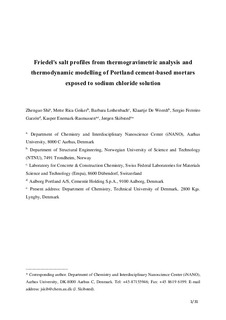| dc.contributor.author | Shi, Zhenguo | |
| dc.contributor.author | Geiker, Mette Rica | |
| dc.contributor.author | Lothenbach, Barbara | |
| dc.contributor.author | De Weerdt, Klaartje | |
| dc.contributor.author | Garzón, Sergio Ferreiro | |
| dc.contributor.author | Enemark-Rasmussen, Kasper | |
| dc.contributor.author | Skibsted, Jørgen | |
| dc.date.accessioned | 2017-12-13T09:26:15Z | |
| dc.date.available | 2017-12-13T09:26:15Z | |
| dc.date.created | 2017-02-23T13:05:00Z | |
| dc.date.issued | 2017 | |
| dc.identifier.citation | Cement & Concrete Composites. 2017, 78 73-83. | nb_NO |
| dc.identifier.issn | 0958-9465 | |
| dc.identifier.uri | http://hdl.handle.net/11250/2471015 | |
| dc.description.abstract | Thermogravimetric analysis (TGA), powder X-ray diffraction (XRD) and thermodynamic modelling have been used to obtain Friedel's salt profiles for saturated mortar cylinders exposed to a 2.8 M NaCl solution. Comparison of the measured Friedel's salt profiles with the total chloride profiles indicates that only a minor part of the chloride ions is bound in Friedel's in the studied Portland cement (P) and limestone blended (L) cement. The chloride binding capacity with respect to the formation of Friedel's salt by consumption of monocarbonate is reached for the P and L mortars, where only a fraction of about 20% of the amount of C3A is found to contribute to formation of Friedel's salt. Higher amounts of Friedel's salt are formed in the metakaolin containing mortars. However, the limited chloride ingress depths prevent quantification of the potential full chloride binding capacity of Friedel's salt in these mortars. The measured amounts of Friedel's salt by TGA and the portlandite profiles show that the maximum amount of Friedel's salt is found in the region with limited leaching of calcium, which is in good agreement with the predicted Friedel's salt profiles. | nb_NO |
| dc.language.iso | eng | nb_NO |
| dc.publisher | Elsevier | nb_NO |
| dc.rights | Attribution-NonCommercial-NoDerivatives 4.0 Internasjonal | * |
| dc.rights.uri | http://creativecommons.org/licenses/by-nc-nd/4.0/deed.no | * |
| dc.title | Friedel's salt profiles from thermogravimetric analysis and thermodynamic modelling of Portland cement-based mortars exposed to sodium chloride solution | nb_NO |
| dc.type | Journal article | nb_NO |
| dc.type | Peer reviewed | nb_NO |
| dc.description.version | acceptedVersion | nb_NO |
| dc.source.pagenumber | 73-83 | nb_NO |
| dc.source.volume | 78 | nb_NO |
| dc.source.journal | Cement & Concrete Composites | nb_NO |
| dc.identifier.doi | 10.1016/j.cemconcomp.2017.01.002 | |
| dc.identifier.cristin | 1453417 | |
| dc.description.localcode | © 2017. This is the authors’ accepted and refereed manuscript to the article. Locked until 5.1.2019 due to copyright restrictions. This manuscript version is made available under the CC-BY-NC-ND 4.0 license http://creativecommons.org/licenses/by-nc-nd/4.0/ | nb_NO |
| cristin.unitcode | 194,64,45,0 | |
| cristin.unitname | Institutt for konstruksjonsteknikk | |
| cristin.ispublished | true | |
| cristin.fulltext | postprint | |
| cristin.qualitycode | 1 | |

